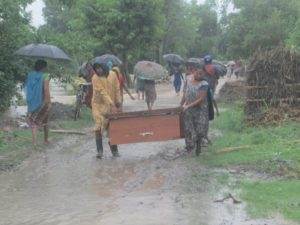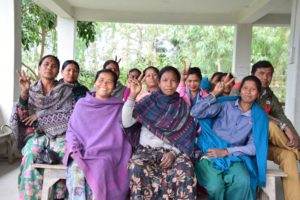Climate change means that Nepal’s annual monsoons are costing more people their lives and livelihoods every year. Our work is proving that preparation can reduce people’s vulnerability to floods and help them become more resilient to the changing climate.
Nepal is a country prone to natural hazards. Among these hazards are floods and landslides. These are so called hydro-meteorological hazards, which simply means they are triggered by extreme rainfall, which Nepal is no stranger to.

People are struggling to protect their homes, their property – and their lives – during this year’s monsoon.
The annual monsoon season takes place between June and September and provides about 80% of Nepal’s annual rainfall. It results in some really heavy downpours that can have disastrous consequences if not predicted and prepared for adequately.
The impact of climate change
In the past couple of years, a warming globe has affected weather patterns, making the monsoon rains increasingly severe and unpredictable. People who have lived with the monsoons for generations have struggled to cope – they are being forced to live with new unexpected hazards and uncertainty.
At the time of writing, fourteen people have died from floods in Nepal and 231 from landslides during the 2020 monsoon season. Many more are missing, injured, or have had their homes and livelihoods destroyed.
Reducing the risk by building vulnerability
As Nepal has high exposure to natural hazards and its people have high vulnerability, what can be done to reduce these annual losses?
Firstly, it’s important to clarify that the monsoon rain in itself is no disaster, it does indeed bring challenges for people in Nepal, but also benefits such as replenishment of aquifers. It can be used to water crops and it’s an essential ingredient of the annual rice crop.
A disaster happens when vulnerable people are exposed to a hazard. For example, when a river floods (hazard) and affects a community next to the river (exposure) who lack the capacity or resources to reduce their flood risk (vulnerability).
To mitigate or prevent a disaster, we need to act on at least one of these risk factors.
- We can try to remove the hazard, make sure the river doesn’t flood, by building bio-dykes to prevent riverbank erosion.
- Exposure can be removed by identifying hazard prone areas and making sure that people don’t live there unwittingly.
- Lastly, we can reduce people’s vulnerability to the hazard – make sure people are resilient, have the capacity, the knowledge, tools, and resources they need to prevent and prepare, thus preventing a natural hazard from turning into a human disaster.
A powerful collaboration allied against disaster

The Community Disaster Management Committee in Nangapur Village.
Reducing vulnerability is exactly what Practical Action is doing in Nepal in response to the monsoon rains. For many years, since 2013 as part of the Zurich Flood Resilience Alliance, we have been working closely with communities to build their resilience to floods.
We’ve worked with the government and mobile phone providers to improve dissemination of early warning messages so people know when a flood is coming and can take appropriate action.
To ensure that warnings reach even those without access to mobile phones or who cannot read, and that people know how to respond to the alerts, we train and support local Community Disaster Management Committees (CDMCs).
We conduct annual flood drills, training and practicing for community members on how to respond in the case of a flood early warning. The CDMCs are trained on disaster risk reduction and management. They create community specific response plans, keep emergency evacuation shelters fit for purpose and create task groups with specialisations such as early warning dissemination, search and rescue, or first aid. They also represent the community in talks with local authorities.
This work saves lives
In 2017, when much of Nepal was inundated by floods and 150 people lost their lives, communities where Practical Action was present were less devastated. This year, despite the floods being described as the worst in 40 years by Dharam Uprety, who leads our climate and resilience work in Nepal, the death toll is comparably low. Community members who we have worked with know when and how to take action in the face of floods, which means lives are saved.
Our work with communities in flood-prone areas is increasing people’s resilience to floods and helping them adapt to the changing climate. We’re helping to make resilience a way of life, so that flooding doesn’t have to mean disaster.
